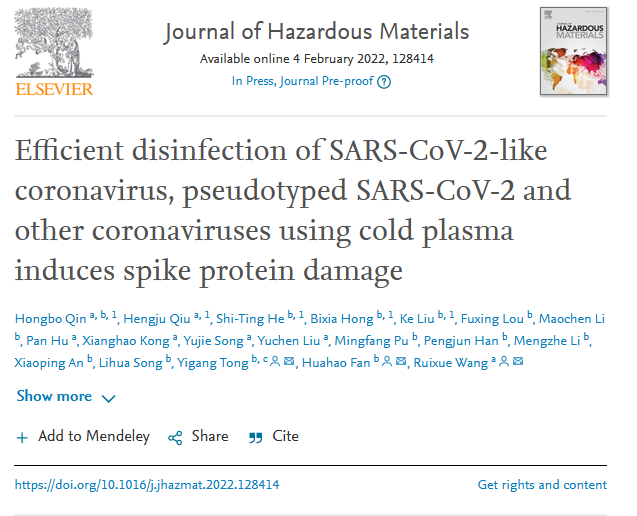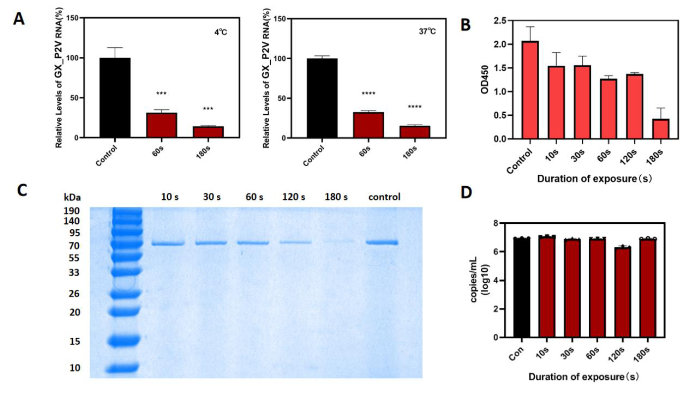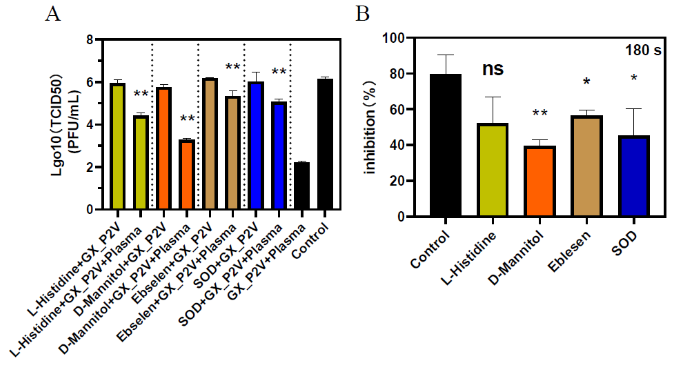
The COVID-19 pandemic in 2019 has become a global public health emergency, and the high infectivity of the SARS-CoV-2 variant has attracted widespread attention. Effective disinfection methods are crucial in preventing the spread of the virus. Unlike traditional disinfection methods such as ultraviolet light, chlorine-containing disinfectants, and 75% ethanol, low-temperature plasma, as a new type of bactericidal technology, can effectively kill bacteria under mild conditions. It has the characteristics of high efficiency, broad-spectrum, green and non-polluting, making it a promising new generation of virus disinfection technology. On February 4, 2022, the team of Wang Ruixue from the School of Mechanical and Electrical Engineering and the team of Tong Yigang and Fan Huahao from the School of Life Science and Technology at Beijing University of Chemical Technology (Beijing, China) published an article online in the prestigious environmental science journal, Journal of Hazardous Materials (IF=10.588), titled "Efficient disinfection of SARS-CoV-2-like coronavirus, pseudotyped SARS-CoV-2 and other coronaviruses using cold plasma induces spike protein damage." This paper confirmed for the first time that low-temperature plasma has the ability to effectively kill coronaviruses (SARS-CoV-2-like coronavirus, various pseudoviruses of coronaviruses, porcine epidemic diarrhea virus, porcine transmissible gastroenteritis virus), elucidating the molecular mechanism by which low-temperature plasma effectively and broadly kills coronaviruses by inactivating the Spike protein on the surface of the coronavirus, laying a solid foundation for the promotion of plasma technology for efficient and broad-spectrum disinfection.

Figure 1: Schematic diagram and workflow of low-temperature plasma virus inactivation.
In this study, researchers initially used low-temperature plasma (CAP) driven by a pulsed power supply to treat the pangolin coronavirus GX_P2V highly homologous to SARS-CoV-2. It was found that CAP could effectively inactivate it within 5 minutes. Subsequently, researchers tested the inactivation effect of CAP on various new coronavirus variants including Delta, as well as on the pseudo-viruses of porcine epidemic diarrhea virus and porcine acute diarrhea syndrome coronavirus. The results showed that CAP could achieve an inactivation rate of over 99% on the above viruses within 5 minutes.

Figure 3: Cold Atmospheric Plasma can damage the novel coronavirus Spike protein in a short time and inhibit virus attachment and entry into cells.
To further elucidate the key active substances of CAP for rapid inactivation of coronaviruses, researchers identified ONOO- (peroxynitrite anion) as the key effector of CAP's efficient inactivation of coronaviruses by using classical CAP-release RONS (reactive oxygen/reactive nitrogen species) scavengers.

Figure 4: The impact of RONS reactive species on coronavirus is ONOO- >O2->1O2>·OH
This research outcome demonstrates that pulsed plasma technology is an efficient broad-spectrum method for inactivating coronaviruses. As a novel disinfection technology, it holds great potential for application and development.
Qin Hongbo, Qiu Hengju, He Shiting, Hong Bixia, and Liu Ke are the co-first authors of this paper from Beijing University of Chemical Technology, with Professors Wang Ruixue, Fan Huahao, and Tong Yigang as corresponding authors. Beijing University of Chemical Technology is the sole completing unit.
Paper link: https://www.sciencedirect.com/science/article/abs/pii/S0304389422002023
